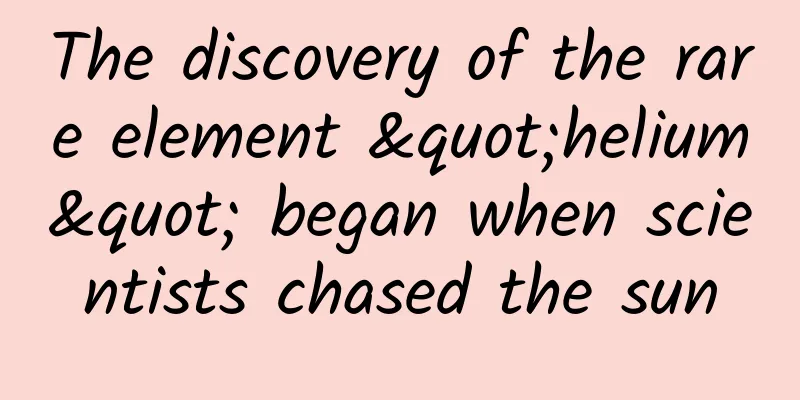The discovery of the rare element "helium" began when scientists chased the sun

|
The discovery of helium is an interesting story that involves both astronomy and chemistry. Helium was first observed in the solar spectrum, and the discovery can be divided into several key stages. Phase 1: Observation of the solar spectrum In 1868, astronomers Jules Janssen and Norman Lockyer independently observed a solar eclipse during the solar corona. They observed an unknown yellow spectral line in the solar spectrum with a wavelength of 587.49nm, which could not be matched to the spectrum of any known element. Lockyer subsequently named this element "helium", after the Greek mythological sun god Helios. They used a tool called a spectrometer to observe the solar spectrum. A spectrometer can break light into a spectrum of different colors, and each element has its own unique spectral line. When observing the solar spectrum, they found a yellow line that did not match the spectral line of any known element. Imagine that each element has its own unique spectral line, like a fingerprint. When Jeanson and Lockyer observed the sun, they were like cosmic detectives and found a mysterious "fingerprint" that was the first clue to helium. Phase 2: Discovery of Helium on Earth In 1895, Swedish chemists Per Teodor Cleve and Nils Abraham Langlet discovered helium by heating uranium ore and observing the gas released while conducting experiments in Sweden. The process is like finding treasure in ore. When scientists heat this special ore, it's like opening a chest of hidden treasure, releasing helium - a valuable element never before found on Earth. Stage 3: Identification of Helium in the Earth's Atmosphere A key figure in this phase was William Ramsay, a Scottish chemist with a particular interest in the study of gases. In 1895, Ramsay accidentally discovered helium in pitchblende (an ore containing uranium) while studying a new element, argon. Through chemical analysis and collaboration with Lockyer, he confirmed that the gas he discovered was the helium previously observed in the solar spectrum. Ramsay won the 1904 Nobel Prize in Chemistry for discovering the rare gas elements (argon, neon, krypton, xenon, radon) and studying their physical and chemical properties. Ramsey's discovery solved a scientific mystery. While processing pitchblende in his laboratory, he discovered a new gas. Through careful experiments and comparisons, he realized that this new gas was helium, which had been previously discovered in the solar spectrum. This was a surprising discovery, proving that helium exists not only in the sun, but also on Earth. This discovery is of great significance to the study of helium. It not only proves the existence of helium on Earth, but also reveals the distribution of helium and other elements in the Earth's atmosphere. This discovery also promotes further research on the role of helium in geochemistry. The identification of helium in the Earth's atmosphere was achieved through chemical analysis of minerals on Earth, which provided important evidence for the existence and distribution of helium and deepened people's understanding of the composition of the Earth's atmosphere. The discovery of helium is a story of exploration that spans astronomy and chemistry. It started with a mysterious yellow line in the solar spectrum, passed through chemical discoveries in minerals, and was finally confirmed as a new element. This story shows the wonder of scientific discovery and the importance of collaboration between different fields. Stage 4: Discovery of Helium Isotopes Humans discovered the existence of helium-3 through the study of nuclear reactions and a deep understanding of isotope theory. There are several key steps in this process: One is the development of isotope theory. In the early 20th century, as research into radioactive elements deepened, scientists such as Frederick Soddy and Ernest Rutherford began to realize that certain elements exist in different mass forms, known as isotopes. This theory laid the foundation for understanding isotopes of light elements like helium-3. The second is the study of particle accelerators and nuclear reactions. In the 1930s, scientists began to use particle accelerators to study nuclear reactions. Through experiments, they were able to produce and observe the products of various nuclear reactions, including different isotopes of light elements. During these experiments, scientists noticed that some nuclear reactions produced a light helium isotope different from helium-4, namely helium-3. The third is the specific identification of helium-3. With the development of spectroscopy and mass spectrometry, scientists can more accurately distinguish and identify different isotopes. Helium-3 is distinguished from helium-4 due to the uniqueness of its mass and nuclear magnetic properties. Through the careful analysis of these nuclear reaction products, scientists were able to confirm the existence of helium-3 and begin to study its properties and behavior. Fourth, the contribution of astrophysics. In the mid-to-late 20th century, with the exploration of space and the study of solar wind and cosmic rays, astrophysicists also observed the existence of helium-3. These discoveries further confirmed the natural existence of helium-3 in the solar system and promoted the understanding of its behavior in the celestial environment. Chief Planner: Qin Shengfei Written by: Qin Shengfei, Li Jiyuan, Tao Gang, Wang Jiamei, Zhao Zizhuo (China Petroleum Exploration and Development Research Institute) |
>>: How did Yunnan become the coffee capital of China? It all started with a "lost book"...
Recommend
This molecular mechanism allows plants to "control their mouths"
Produced by: Science Popularization China Author:...
Domestic mobile phones are quietly experiencing a price increase. Will consumers pay for them?
After smartphones entered the period of stock rep...
A guide to creating automotive-related short video content!
Hou Wenliang, 43, never dreamed that his interest...
Ajun Short Video Operation Course, a systematic course starting from zero basis
Ajun Short Video Operation Course, a systematic c...
10 classic marketing planning cases!
When doing marketing planning , there are three t...
Can’t wear a turtleneck, is it because I’m being pretentious or a disease?
Seasonal cooling season There are always people w...
3 days, 0 budget, sales of 10,000 goods, all the activity methodology is here!
The article combines the author's actual expe...
In which field is it easier to make short videos? Which industries are short videos suitable for?
If you want to shoot short videos , choosing a go...
Solution for responsive images to adapt to different interfaces with the same image source
[[164364]] Ever since Ethan Marcotte started talk...
Can't stop the price increase? A brief analysis of the reasons behind the SSD price increase
In recent times, the biggest news in the SSD mark...
Patent exposed! Google is about to launch a foldable smartphone
On March 14, according to foreign media mspowerus...
Mobile games are now on the news broadcast, what are you waiting for?
[[125808]] On the evening of January 4, the first...
A must-have for big Vs: Which Weibo users love to repost the most?
Which tweets are worth retweeting? Are some tweet...
Excluding Guoxin factors, revenue increased by 18.3% year-on-year. Interpretation of the three major strategies behind NetQin's Q1 financial report
On May 27, NQin Technology Co., Ltd. (NYSE: NQ) a...
User points and growth value retention system
How to make users feel that points are valuable? ...









